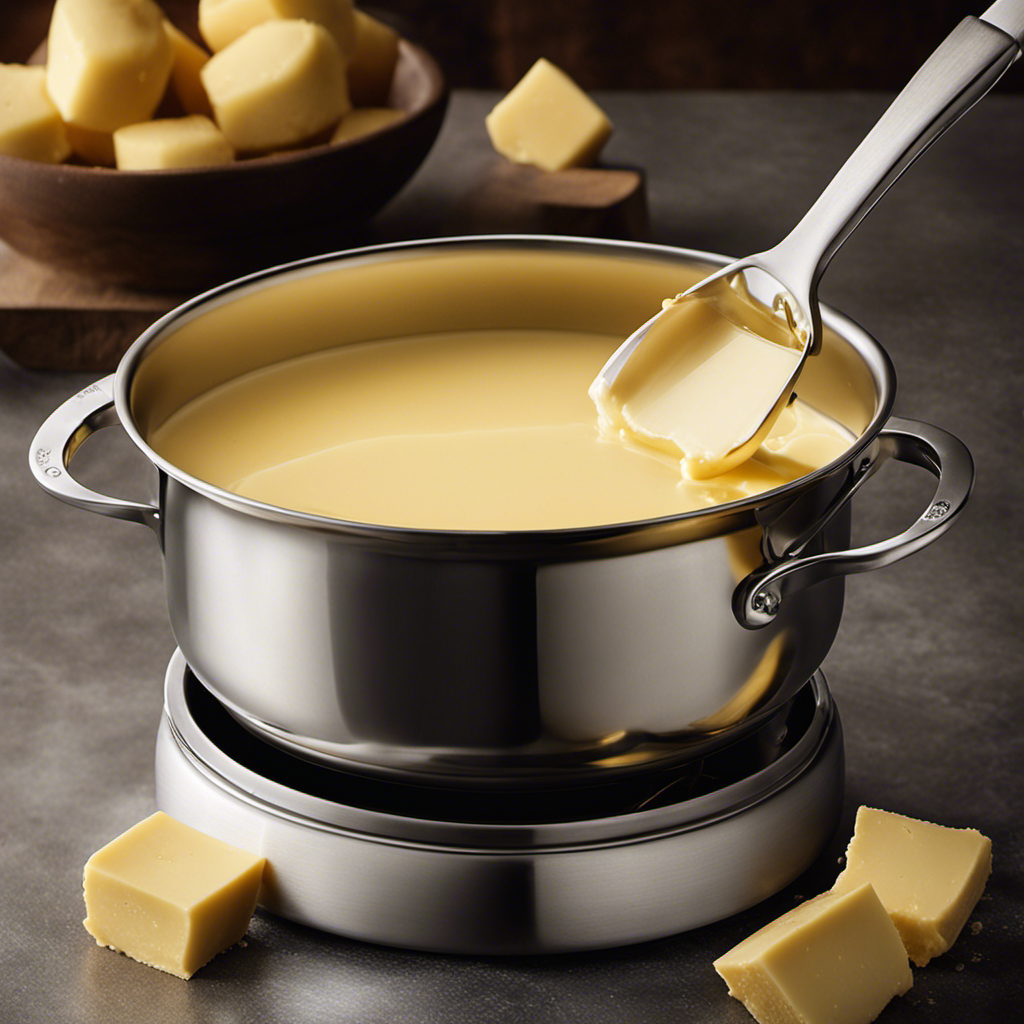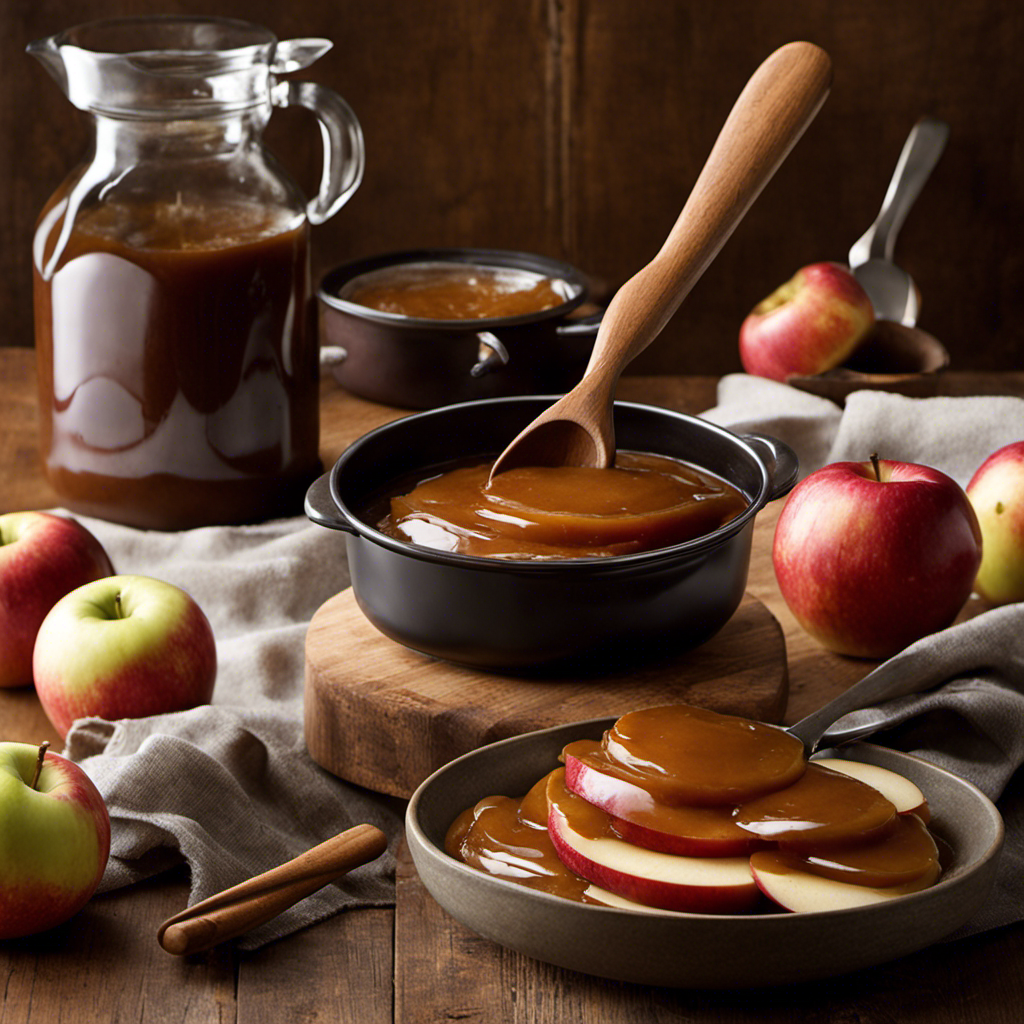Did you know that nearly 90% of baking recipes call for softened butter? If you’ve ever found yourself needing to quickly soften cold butter, this article is just for you.
In this guide, I will show you a simple and efficient method to soften butter using just a glass. With a few easy steps, you’ll have perfectly softened butter, ready to use in your favorite recipes in no time.
Key Takeaways
- Choose a microwave-safe glass with a lid or cover
- Adjust the softening time for different containers to avoid melting the butter completely
- Softening butter with a glass is a simple and effective method for spreadability
- Proper butter storage in an airtight container at room temperature helps maintain spreadability
Selecting the Right Glass
First, you’ll want to make sure you’ve selected the right glass for softening your butter. When choosing a glass, opt for one that is microwave-safe and has a lid or cover. This will help retain the heat and moisture needed to soften the butter effectively. Avoid using glasses with metal accents or coatings, as they may cause sparks or damage the microwave.
Additionally, consider the size of the glass. A taller glass will allow for easier handling and stirring of the butter. If you don’t have a suitable glass, there are alternative softening methods you can try. These include using a microwave-safe ceramic bowl or a plastic container with a lid. Just remember to adjust the softening time accordingly to avoid melting the butter completely.
Preparing the Butter
Next, you’ll want to place the cold butter inside the glass container. When selecting the right glass, opt for one that is microwave-safe and has a lid to prevent any mess. This will ensure efficient and safe melting of the butter.
Once the butter is in the glass, cover it with the lid, leaving a small vent for steam to escape. This will help soften the butter evenly and prevent any splattering in the microwave.
Set the microwave to a low power setting, around 20-30% power, and heat the butter in short intervals of 10 seconds. This time-saving tip prevents overheating and allows for better control of the softening process.
Remember to check the butter after each interval, and stop microwaving once it reaches the desired softness.
Room Temperature Vs. Cold Butter
When it comes to baking, I’ve always had a strong preference for spreadable butter. I find that it mixes more easily with other ingredients and creates a smoother texture in the final product.
However, I’ve also heard concerns about the impact of using room temperature butter on baking consistency. Some argue that using cold butter can help create flakier pastries and biscuits.
I’m curious to delve into this topic further and explore the evidence behind these claims.
Spreadability Preference
If you prefer your butter to be easily spreadable, you can soften it with a glass. Softening butter can be done in a few different ways, but using a glass is a simple and effective method.
To do this, start by placing a stick of cold butter in a microwave-safe glass. Fill the glass with hot water, making sure to completely submerge the butter. Let it sit for a few minutes, allowing the heat to soften the butter.
Once the butter is soft, carefully pour out the water and dry the glass. Your butter will now be easily spreadable and ready to use. This technique is especially useful if you forgot to take your butter out of the fridge ahead of time.
Proper butter storage is also important for spreadability. To keep your butter soft and spreadable, store it in an airtight container at room temperature.
Baking Consistency Concerns
To ensure consistent texture and doneness in your baked goods, it’s important to preheat your oven to the specified temperature before adding your batter or dough. Maintaining the correct butter temperature is crucial for achieving the perfect texture. Here are four reasons why it’s important:
-
Even distribution: When the butter is at the right temperature, it mixes evenly with other ingredients, resulting in a smooth and uniform batter or dough.
-
Proper leavening: Butter at the correct temperature helps the baking powder or baking soda to activate evenly, ensuring your baked goods rise properly.
-
Creaming ability: Softened butter blends easily with sugar, creating a light and fluffy texture in cakes and cookies.
-
Melting point: When butter is at the right temperature, it melts evenly during baking, enhancing the overall texture of your baked goods.
Now that we understand the importance of butter temperature, let’s move on to the next step: placing the butter in the glass.
Placing the Butter in the Glass
You can start by placing the softened butter in the glass. When selecting the right glass, it’s important to choose one that is microwave-safe and can hold the amount of butter you need. A glass with a lid or cover is also helpful to prevent any splattering while melting.
Once you have chosen the glass, simply place the softened butter inside. It is important to monitor the butter’s progress while it’s in the microwave. Set the microwave to a low power setting and heat for short intervals, checking on the butter every 10-15 seconds. This will ensure that the butter softens evenly without melting completely.
Keep a close eye on the butter to prevent it from overheating or becoming too liquid.
Adding Warm Water
Once the butter has been placed in the glass, add warm water to aid in the melting process. This step is crucial in softening the butter to the desired consistency. Here’s how to do it:
-
Pour warm water into the glass, making sure to cover the butter completely. The warmth of the water will help speed up the melting process.
-
Use a spoon or a butter knife to gently stir the mixture. This will help distribute the heat evenly and promote faster melting.
-
Monitor the butter’s progress by checking its texture periodically. You want it to be soft and spreadable, but not completely melted.
-
Be patient and give the butter enough time to soften. Depending on the initial hardness of the butter, it may take anywhere from a few minutes to an hour to reach the desired consistency.
Letting the Butter Soften
When it comes to baking, room temperature butter can make all the difference. Not only does it mix more easily with other ingredients, but it also helps create a light and fluffy texture in baked goods.
In this discussion, I will share some time-saving tips for softening butter quickly, as well as alternative methods that can be used when you don’t have room temperature butter on hand.
Room Temperature Butter
To soften butter at room temperature, simply leave it out on the counter for a few hours. This method allows the butter to warm up gradually, resulting in a soft and spreadable texture.
But there are more advantages to keeping butter at room temperature than just its spreadability. Here are four reasons why I prefer to store my butter outside the fridge:
-
Enhanced flavor: Room temperature butter has a richer, more pronounced flavor compared to cold butter.
-
Easier spreading: Softened butter spreads effortlessly on bread, toast, and other baked goods, making them even more enjoyable.
-
Improved texture: Soft butter blends smoothly into recipes, ensuring a better consistency in your cooking and baking.
-
Quick accessibility: Having butter readily available on the counter means you can use it whenever you need it, without waiting for it to soften.
Time-Saving Tips
Keeping butter at room temperature not only enhances its flavor and texture, but it also provides quick accessibility for all your culinary needs. However, there are times when you need softened butter quickly and don’t have the luxury of waiting for it to reach room temperature naturally.
That’s where time-saving hacks come in handy. One of my favorite tricks for softening butter in a hurry is using a glass. Simply fill a glass with hot water and let it sit for a minute or two to warm up the glass. Then, pour out the water and quickly place the warm glass upside down over the cold butter.
The heat from the glass will gently soften the butter, maximizing efficiency and saving you valuable time in the kitchen.
Alternative Softening Methods
After learning about time-saving tips for softening butter, let’s explore some alternative techniques that can come in handy when you’re short on time or don’t have a microwave.
These butter softening hacks have been tried and tested, and they work like a charm!
-
Grating: Grating cold butter using a cheese grater allows it to soften quickly and evenly. It’s perfect for recipes that call for softened butter.
-
Pounding: Place cold butter between two sheets of parchment paper and pound it gently with a rolling pin. This method softens butter in no time.
-
Hot water bath: Fill a glass with hot water and let it sit for a minute. Empty the water, cover the butter with the warm glass, and watch it soften within minutes.
-
Cutting into small cubes: Slice cold butter into small cubes and let them sit at room temperature. The increased surface area helps the butter soften faster.
With these alternative softening techniques, you’ll never have to worry about hard butter again!
Monitoring the Butter’s Progress
You’ll want to check on the butter’s progress by taking a quick peek every few minutes. This will help you ensure that the butter is softening evenly and not melting completely. Here are some monitoring techniques and troubleshooting tips to help you along the way:
| Monitoring Techniques | Troubleshooting Tips |
|---|---|
| Observe the butter | If the butter is melting too quickly, try using a lower heat setting or placing the glass in a cooler spot, such as on a plate of ice. |
| Touch the butter | If the butter feels too soft or mushy, place it in the refrigerator for a few minutes to firm up before continuing the softening process. |
| Test the butter | If the butter is still too firm after the recommended time, continue softening in short intervals, checking and stirring in between to prevent uneven softening. |
Stirring or Flipping the Butter
While stirring or flipping, be mindful not to agitate the butter too much, as this could cause it to melt unevenly. The stirring technique is crucial in achieving a soft and spreadable consistency. Here are four reasons why this technique is beneficial:
-
Control: By stirring the butter, you have complete control over the softening process. You can adjust the speed and intensity to achieve the desired result.
-
Even Melting: Stirring helps distribute the heat evenly, preventing any hot spots that may cause the butter to melt unevenly.
-
Texture: The act of stirring creates a smooth and creamy texture, making it easier to spread on bread or toast.
-
Microwave Alternative: If you don’t have a microwave or prefer not to use one, stirring is a great alternative method to soften butter.
Avoiding Melted Butter
When it comes to softening butter, it’s important to avoid using butter substitutes. While these substitutes may claim to be healthier, they often have a different texture and can affect the taste and consistency of your baked goods. Instead, opt for the real deal.
One of the best ways to soften butter is by letting it sit at room temperature. This allows the butter to naturally soften without the risk of melting. To ensure that your butter is at the right temperature, you can use a simple trick with a glass.
Here is a table outlining the steps to soften butter using a glass:
| Step | Instructions |
|---|---|
| 1 | Take a stick of butter out of the refrigerator |
| 2 | Place the butter in a glass |
| 3 | Let the glass sit at room temperature for about 30 minutes |
| 4 | Check the butter’s softness by pressing it with a finger |
| 5 | If the butter is still too firm, continue to let it sit until it reaches the desired softness |
Checking for Desired Softness
When it comes to achieving the perfect texture for butter, there are a few visual cues that can be helpful.
One of the key indicators of desired softness is the ability to easily spread the butter with a knife.
Additionally, the butter should have a smooth and creamy consistency without any lumps or chunks.
To ensure that the butter meets these criteria, a simple butter consistency test can be performed using a spoon or a fork.
Visual Cues for Softness
You’ll know the butter is soft enough when it easily spreads on a piece of bread. But how do you visually determine if your butter has reached the desired level of softness? Here are some visual cues to help you gauge the softness of your butter:
- Texture: Soft butter will have a smooth and creamy texture, without any lumps or chunks.
- Color: Soft butter tends to have a lighter, more pale yellow color compared to the solid, chilled butter.
- Shine: Soft butter reflects light and appears slightly glossy, indicating its spreadability.
- Consistency: When you press a spoon into soft butter, it should yield easily, without any resistance.
These visual cues can help you determine if your butter is soft enough for your preferred spreadability. So next time you’re softening butter, keep these cues in mind for perfectly spreadable results.
Butter Consistency Testing
Determining the consistency of softened butter can be done by pressing a spoon into it to check for easy yielding. Softened butter should have a smooth and creamy texture, allowing the spoon to easily glide through it. If the butter is too firm and resists the pressure, it is not fully softened and may not incorporate well into your recipe.
On the other hand, if the butter is too soft and spreads easily, it may be too warm and could affect the final outcome of your baked goods. It is important to note that the ideal consistency of softened butter is achieved when it reaches a temperature of around 65 to 70 degrees Fahrenheit, which is just below its melting point.
To prevent over-softening, a butter knife can be used to cut small pieces of butter and distribute the warmth evenly. By following these guidelines, you can ensure that your softened butter is at the perfect consistency for your baking needs.
Storing Softened Butter
To keep your softened butter fresh, store it in an airtight container in the refrigerator. Storing softened butter properly is essential to maintain its quality and prevent it from going bad. Here are some time-saving tips to help you store your softened butter effectively:
-
Use an airtight container: This will prevent any odors or flavors from seeping into the butter and keep it fresh for longer.
-
Refrigerate it: Storing softened butter in the refrigerator will maintain its texture and prevent it from melting or becoming too soft.
-
Label the container: By labeling the container with the date, you can easily keep track of its freshness and avoid using expired butter.
-
Use small portions: To save time, divide the softened butter into smaller portions before storing. This way, you can easily grab the amount you need without having to soften an entire stick.
Frequently Asked Questions
Can I Use Any Glass to Soften Butter or Are There Specific Types of Glasses That Work Best?
Different glasses can be used to soften butter, but some types work best. To soften butter without warm water, place it in a glass jar and cover it with a glass bowl. The heat from the trapped air will soften the butter.
How Long Does It Typically Take for Butter to Soften Using This Method?
It typically takes about 10-15 minutes for butter to soften using the glass method. However, if you’re in a hurry, you can use a microwave instead of warm water to speed up the process.
Can I Microwave the Butter Instead of Using Warm Water to Speed up the Softening Process?
I prefer using warm water to soften butter because it’s a tried and true method. However, if you’re in a hurry, microwaving is a viable alternative. Just be cautious and use short bursts to prevent melting.
What Should I Do if the Butter Starts to Melt Instead of Just Softening?
If the butter starts to melt instead of softening, I would recommend taking it out of the glass and placing it in the refrigerator for a few minutes to solidify. This will prevent further melting and salvage the butter.
How Long Can I Store Softened Butter and What Is the Best Way to Keep It Fresh?
I keep softened butter in an airtight container in the fridge for up to two weeks. To keep it fresh longer, you can freeze it for up to six months. Just make sure to thaw it before using!
Conclusion
In conclusion, using a glass to soften butter is a simple and effective method. By selecting the right glass and preparing the butter properly, you can achieve the desired softness without melting it.
Adding warm water and stirring or flipping the butter helps to evenly distribute the heat. Remember to check for the desired softness and store the softened butter appropriately.
As the old adage goes, ‘Patience is a virtue,’ and in this case, it will reward you with perfectly softened butter for all your culinary creations.










